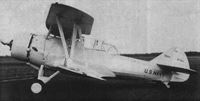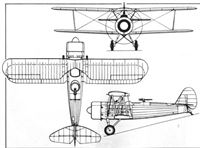Фотографии
-
Based on the two-seat Corsair reconnaissance biplane, the Vought V-80 was purchased by Peru (shown) and Argentina.
Among 1933 single-seater fighter variants of the Corsair were: V-80F with twin Colt MG-40s, 675 h.p. Hornet SD in N.A.C.A. cowling, and 150-gal. tankage; V-80P with Townend ring and unspatted wheels, for Peru; V-85G (similar to V-80F) for Germany. Series was adaptable as single-float seaplane.Самолёты на фотографии: Vought O2U/O3U/V-65/V-93 Corsair - США - 1926
-
Flown in 1933, the Vought XF3U-1 met a US Navy requirement for a two-seat fighter that was abandoned after prototype evaluation.
Самолёты на фотографии: Vought F3U/SBU/V-142 - США - 1933
-
Flown in 1933, the Vought XF3U-1 met a US Navy requirement for a two-seat fighter that was abandoned after prototype evaluation.
Самолёты на фотографии: Vought F3U/SBU/V-142 - США - 1933
-
Регистрационный номер: PM-1 VL PYORREMYRSKY. The supply of fighters by Germany to the Finnish Air Force in 1945 had to be suspended because of the worsening position of production for the Luftwaffe. To safeguard against this eventuality, the Finnish Air Force laid down a specification for a single-seat interceptor fighter which would be powered by the German 1,475-h.p. Daimler-Benz DB 605 AC 12-cylinder inverted-Vee inline motor. The design was to use wooden construction in order to conserve vital metal supplies. The result was the trim-looking VL Pyorremyrsky (Whirlwind) which was first flown in 1945. Only one prototype was completed when the final truce with the Russians was concluded. Two cannon, one in each wing, were fitted. The Pyorremyrsky was designed and built by VL-Valtion Metallitehtaat, Lentokonetehaat - the State Metal Works, Aircraft Factories. The roundels are white, blue and white.
Самолёты на фотографии: VL Pyorremyrsky - Финляндия - 1945
-
Design of the VL Pyorremyrsky, of which this was the only example, was clearly influenced by the Bf 109.
Самолёты на фотографии: VL Pyorremyrsky - Финляндия - 1945
-
For service ashore, the Vought FU-1 could be fitted with a wheeled undercarriage, but it served primarily as a floatplane aboard US battleships.
Самолёты на фотографии: Vought UO/FU - США - 1922
-
For service ashore, the Vought FU-1 could be fitted with a wheeled undercarriage, but it served primarily as a floatplane aboard US battleships.
Самолёты на фотографии: Vought UO/FU - США - 1922
-
Protracted development prevented the Vought XF2U-1 from competing for the US Navy requirement for which it was designed.
Самолёты на фотографии: Vought XF2U - США - 1929
-
Самолёты на фотографии: Vought XF2U - США - 1929
Статьи
- Airscene Headlines
- Fighter A to Z
- In print
- Talkback
- B.Gunston, Y.Gordon - The Extinct Bison (2)
- D.Allport - History of In-Flight Refuelling
- D.Allport - Worldwide Army Aviation Census
- D.Baker - Feline Claws. The nine lives of the F-14
- F.Mormillo - Flying Wing Homecoming /Veteran & Vintage/
- G.Jones - Northwest is Northbest
- G.Paloszi-Horvath - Force de Frappe. French Air-Delivered Nuclear Weapons
- P.Relman - Fokker 70 ... Fellowship Too
- R.Braybrook - The New Russian Trainers
- R.Francillon - High Tide. The ANG pioneers wing-strength combat air refuelling








